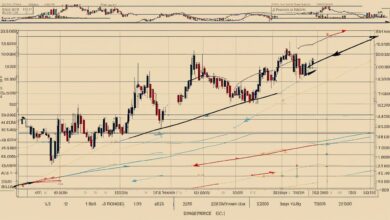Understanding Naked Puts: A Beginner’s Guide

Are you curious about naked puts and how they work? If you’re new to options trading, understanding the concept of selling naked puts can be a bit daunting. But fear not! In this beginner’s guide, we’ll break down everything you need to know about naked puts, including what they are, how they work, and how they differ from other strategies.
So, what exactly is a naked put? In simple terms, it’s an options strategy where the investor sells put options without holding a short position in the underlying security. By doing so, the investor aims to capture the premium of the option on an underlying security that is expected to increase in value.
However, it’s important to note that selling naked puts comes with its own set of risks. The seller must be prepared to potentially own the security for at least a month or longer if the put option is exercised. While naked puts have limited upside profit potential, there is theoretically significant downside loss potential from the current price of the underlying down to zero.
Key Takeaways:
- A naked put involves selling put options without holding a short position in the underlying security.
- The strategy aims to capture the premium of the option on an underlying security expected to increase in value.
- Naked puts have limited upside profit potential and significant downside risk.
- Sellers must be prepared to potentially own the security for at least a month or longer.
- Understanding the risks and rewards is essential before considering naked puts in your options trading strategy.
What Is a Naked Put?
A naked put is an options strategy where the investor writes or sells put options without having a short position in the underlying security. The seller of an uncovered put is known as a naked writer. The primary purpose of this strategy is to capture the premium of the option on an underlying security that is expected to increase in value. The breakeven point for the writer of a naked put is the strike price plus the premium received.

One of the key aspects to understand about a naked put strategy is that the sold option is unprotected or uncovered. This means the seller does not have a hedging position to mitigate potential losses if the underlying security’s price decreases significantly.
A naked put strategy is typically implemented by investors who are bullish on the underlying security and want to generate income from selling put options. The strategy allows them to collect the premium upfront but carries the risk of having to buy the stock at a potentially higher price if the option is exercised.
Evaluating Risks and Rewards of Naked Puts
Selling a short put presents an opportunity to profit from a stock’s upward movement while committing to buy the stock at the strike price if the option is exercised. Understanding the potential risk is crucial, as a substantial loss may occur if the stock value plummets. However, the risk is limited to the disparity between the stock’s price and the strike price, while the potential gain is restricted to the premium received for the put option sale. This investment strategy requires careful evaluation of the potential rewards and risks involved in naked put option contracts, which can help in making informed decisions in options trading.
Potential Gains from Naked Puts
Selling a put option presents the potential to profit from the premium received, making it an essential investment strategy. If the stock price remains above the strike price, the option expires, and the trader retains the premium. The maximum profit is attained when the stock price exceeds the strike price at expiration. Essentially, the premium received represents the maximum potential gain from selling naked puts. This premium income is a key advantage of utilizing this options contract. Embracing this approach in trading empowers investors to leverage short put positions for potential gains while mitigating risk.
Possible Pitfalls and How to Avoid Them
While selling naked puts offers the potential to profit from a stock’s price appreciation, it’s crucial to understand the potential risks involved. The significant potential loss if the stock price sharply declines and the assignment risk of having to purchase the stock at a higher price are important considerations. Implementing risk management strategies, such as employing stop-loss orders and performing careful market analysis, can help traders mitigate these potential pitfalls. By strategically utilizing these risk management techniques, traders can navigate the potential downsides of naked puts and enhance their investment strategy.
Process of Selling Naked Puts
The process of selling naked puts requires a margin account with specific margin requirements, essential for executing this investment strategy. Traders stand to profit from the premium received from the sale, which is at risk of loss when engaging in naked put option contracts. Understanding the underlying asset and market price is crucial when contemplating this naked call option trading strategy. It’s imperative to assess the risks and rewards associated with selling naked short puts in options trading, and carefully evaluate the potential outcomes based on market conditions and the selected options contract.
The Prerequisite Knowledge
Before engaging in selling naked puts, it’s imperative for traders to possess a comprehensive comprehension of options trading. Recognizing the seller’s obligation holds paramount importance prior to venturing into naked puts, while ensuring meticulous documentation is in place. Additionally, holding a long stock position is a fundamental prerequisite for selling naked puts, and seeking invaluable investment advice from professionals can be instrumental in this process. Embracing these prerequisites sets the stage for a well-informed and strategic approach to engaging in the selling of naked puts within the options market.
Step-by-step Guide to Selling Naked Puts
Assessing the current market conditions is critical before engaging in selling naked puts. It helps to determine the potential profitability and risks associated with the investment strategy. When selecting a strike price, it is essential to consider the underlying asset’s performance and the options contract’s specific details. Evaluation of the expiration date is crucial in making informed decisions when selling naked puts, as it directly impacts the investment’s outcome. Understanding the potential risks involved is imperative for anyone considering a naked put investment strategy. Implementing a strategy for selling naked puts requires a comprehensive assessment of potential profit and loss to make.
Naked Put vs. Covered Put
A naked put option strategy is different from a covered put strategy. In a covered put, the investor holds a short position in the underlying security for the put option. The covered put works similarly to a covered call strategy, with the main difference being that the covered put trader aims to profit from a mildly declining price of a security, while a covered call trader expects a mildly rising price. The covered put involves a short position and a put option, while the uncovered put only involves selling put options.
When comparing a naked put to a covered put strategy, it’s important to consider the risk and potential outcomes of each approach. A naked put exposes the investor to potentially unlimited losses if the price of the underlying security falls significantly. On the other hand, a covered put limits the investor’s risk since they already have a short position in the security.
For investors seeking to profit from a mildly declining price of a security, a covered put strategy can be an effective tool. By combining a short position with a put option, investors can hedge their bet against a potential decrease in the stock’s value. This strategy allows the investor to generate income from the premium received from selling the put option.
On the other hand, a naked put strategy is more speculative in nature. It involves selling put options without holding a short position in the underlying security. This strategy is suitable for investors who believe the price of the underlying security will rise or remain stable. By selling naked puts, investors can collect the premium and potentially profit if the price stays above the strike price until the expiration date.
Here’s a comparison between a naked put and a covered put strategy:
| Naked Put | Covered Put |
|---|---|
| Strategy focused on selling put options without holding a short position in the underlying security. | Strategy combining a short position in the security with a put option. |
| Higher potential for profit if the price of the underlying security remains above the strike price. | Profit potential limited to the premium received from selling the put option. |
| Potentially unlimited losses if the price of the underlying security falls significantly. | Limited risk due to the short position in the security. |
It’s essential for investors to thoroughly understand the risks and potential outcomes of both strategies before implementing them. Consulting with a professional financial advisor or broker can provide further guidance and insights.
Using Naked Puts
Naked puts are considered high-risk strategies and should only be undertaken by experienced options investors. The margin requirements for this strategy are often high due to the potential for substantial losses.
Investors who believe that the price of the underlying security will rise or stay the same may write put options to earn the premium. If the stock stays above the strike price until the expiration date, the writer keeps the entire premium. However, if the stock falls below the strike price, the writer may be required to buy the stock at a loss.

Notable Quotes:
“Writing naked options closer to expiration takes advantage of time decay and can increase profitability.”
“Strategically selecting strike prices reduces the distance the market needs to move for the option to be profitable.”







